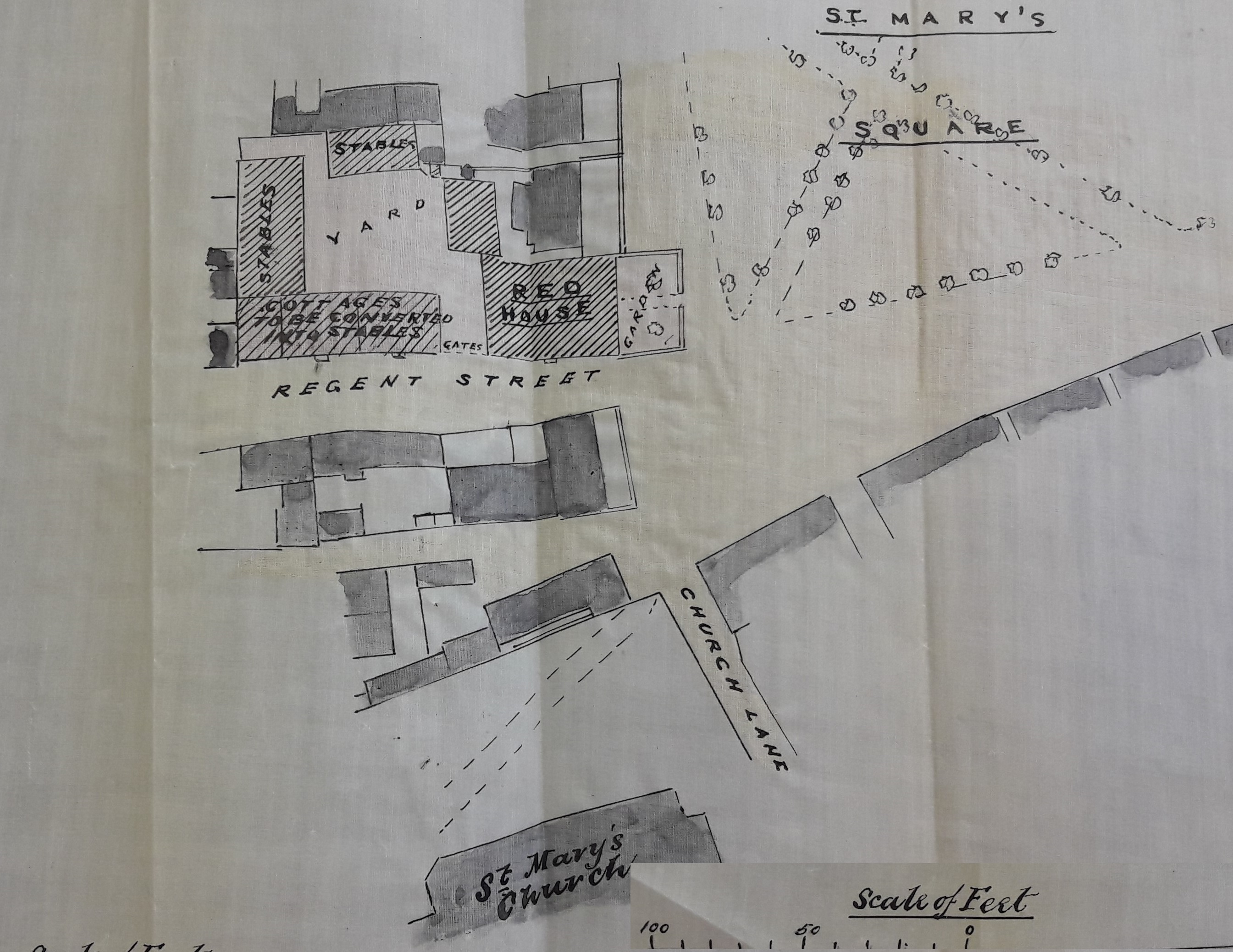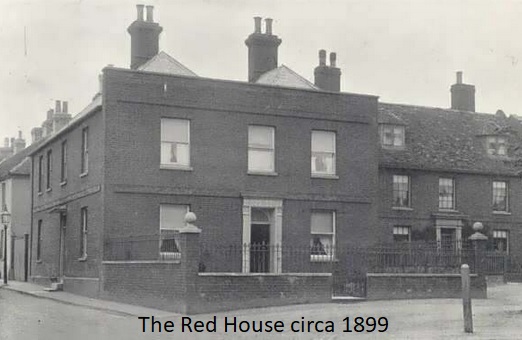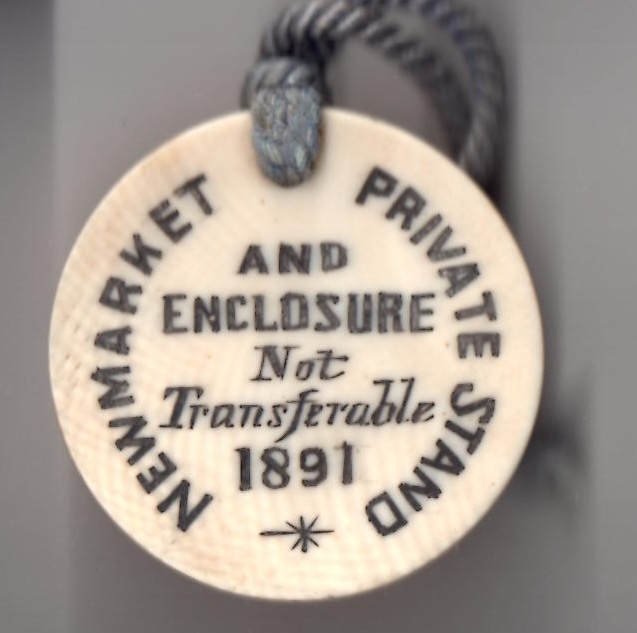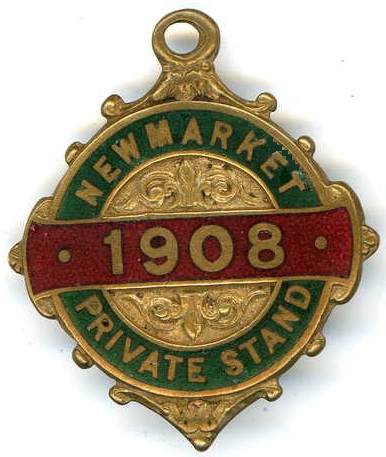This section is a story of 2 different Red House Stables almost a century apart. The first chapter relates the history of The Red House, St Mary's Square.
Up to July 1884 Ernest Clay Ker Seymer
In 1884 Ernest Clay Ker Seymer, a local magistrate, lived in the Red house on St Mary's Square but sold it to Isaac Bates. E Clay Ker Seymer and his wife then moved to a new house which he had built on the High Street. An unfortunate incident occurred at the new house in December 1884 when Mr J Arthur, a painter and decorator from London, who E Clay Ker Seymer had engaged to decorate the new house, died suddenly whilst at work. A later inquest recorded death from natural causes. It is thought that Ernest Clay Ker Seymer died on Sunday 18th June 1899 aged 66.
July 1884- 1887 Isaac Bates
Isaac Bates purchased the Red House from E Clay Ker Seymer and resided there until his death in 1887. Although he lived in the Red House, the yard, consisting of 8 stables, was leased to Matt Dawson from 1886 for £120 per annum.
1887-July 1888 William Matthews
On the death of Isaac Bates his executors sold the Red House to William Matthews who lived there for a year and continued to lease the yard to Matt Dawson.
1886-July 1887 Mathew Dawson
Mathew Dawson, without doubt the best trainer of his generation whilst at Heath House Stables, was nearing retirement, but had trained a smaller string of his own horses and those of Lord Falmouth at Red House Stables. When he heard that the lease of Exeter House Stables was to become available in July 1887, he relinquished his lease on Red House and took over at Exeter House Stables, along with his nephew A Briggs who was just starting his training career. During the same time period Dawson maintained a string at Melton House Stables, Exning, in 1889.
Martin Gurry was born in Nottinghamshire on 18th October 1842, and although his family had no connection with racing, this did not deter Gurry from making a name for himself in the sport. He became apprentice to William Oates at Manor House Stables, located at the famous northern training centre of Middleham, before moving on to gain further experience with C Wintringham and James Watson. Although he had a few rides on the Flat, he was not a distinguished jockey, and this period of his life did not give a pointer to the exceptional trainer he later became. He was head lad to Robert Peck at Russley Park when James Merry was heavily involved at that establishment, winning the 1873 Derby with Doncaster, and the 1873 Oaks and St Leger with Marie Stuart. In 1884 Peck part-owned The Bard, who won 16 straight races as a two-year-old, including the Brocklesby Stakes. This was a record which stood for almost a century until Provideo equalled it in 1984. In all, The Bard, trained at Park Lodge for Peck by his head lad Martin Gurry, won 23 of his 25 races, including the 1886 Goodwood and Doncaster Cups. Gurry had moved to Newmarket, where Bob Peck set him up as a private trainer at Park Lodge Stables. He then took a gamble and moved to Bedford Lodge to become private trainer to George Alexander Baird, aka Mr Abington.

January 1892-95 Charlie Maidment
Charlie Maidment, born on 4th April 1845 at Sixpenny Handley, Dorset, was famous for dead-heating in the Flat Jockey's Championship in both 1870 and 1871, the first with W Gray, each recording 76 winners, and the second with George Fordham, each getting 86 winners. He won every English Classic apart from the 2000 Guineas, partnering Hannah (SR 2014) in 1871 to land the Fillies Triple Crown. The next year he won the Epsom Derby aboard Cremorne (SR 2065) and the St Leger on Wenlock (SR 1881), while in 1876 he captured the St Leger for a second time on Kisber (SR 2061). He is the only jockey to have won the early season Lincoln Handicap 4 times, in 1868 on Indigestion, in 1870 on Royal Rake, in 1872 on Guy Dayrell, and in 1873 on Vestminster. He became a bankrupt in November 1875, but won the Epsom Derby the next year to clear his debts. When his riding days were over he began to train, initially training Goldby's horses at Druids Lodge. Once he had proved himself to be an effective trainer, in January 1892, with support from Lord Howe, he took sole charge of Red House Stables, taking with him Lord Howe's Varingian and Golf Juan. They were part of a small nucleus of horses which had been picked up cheaply to get Maidment started.

In January 1896 American horses owned by William Duke and Enoch Wishard took up their quarters at The Red House on St Mary's Square, with jockey Lester Berchert Reiff landing just afterwards, while Tod Sloan followed a year later. Enoch Wishard, described as hawk-faced, was a blacksmith in his native USA and imported lighter aluminium racing plates from America which, he claimed, were worth 4 lengths over a mile. William Duke had made his fortune from oil and lumber. The boxes at the Red House Stables were light, airy and cool, quite the opposite of traditional English ones at that time, which sometimes even had their ventilation holes plugged. In the early days of the 1896 season the Red House string was almost ignored by the bookmakers. Their first winner, Wishard, was priced at 8/1 and seemingly only supported by his owner, while at Newmarket's first July meeting the winners flowed but the prices did not shrink. On just 2 days of the meeting Helen Nichols won at 100/12, Somatose at 100/8, George H Ketcham at 6/1 and Mack Briggs at 6/1, all ridden by Lester Reiff. A fifth winner would have followed had Reiff not mistaken the winning post. Although the triumvirate of Wishard, Duke and Reiff did not return for the 1897 season, it did not stop Lord Rosebery from venting his annoyance of the upstarts from America plundering his prizes. Lord Rosebery won the 1897 Gimcrack with Mauchline 7/1 trained by Walters junior and ridden by Fagan, which gave the good Lord the right to make the Gimcrack speech at the Gimcrack dinner. His speech began, 'The sport we honour tonight was never better and purer than at this moment, never more honest for its followers'.
May 1896 Wilton Welter Handicap Plate at Manchester WISHARD 8/1 owned and trained by Enoch Wishard and ridden by Lester Reiff
1st July 1896 Visitors Plate at Newmarket HELEN NICHOLS 100/12 owned and trained by Enoch Wishard and ridden by Lester Reiff
1st July 1896 Newmarket Maiden Plate SOMATOSE 100/8 owned and trained by Enoch Wishard and ridden by Lester Reiff
2nd July 1896 Plantation Stakes at Newmarket GEORGE H KETCHAM 6/1 owned and trained by Enoch Wishard and ridden by Lester Reiff
2nd July 1896 Newmarket Plate MACK BRIGGS 6/1 owned and trained by Enoch Wishard and ridden by Lester Reiff

For over 4 centuries racing has been staged in Newmarket, but how have the racecourses evolved from an initial starting point at Fleam Dyke Pumping Station, some 8 miles from the town, with a winning post barely 200 metres from the town centre, into two world recognized, excellent racecourses and a universal acceptance that Newmarket is the Headquarters of racing?
To access an interactive racecourse map showing over 50 individually named racecourses CLICK HERE. The map will enable you to:-
1. Determine when extended races over 8 miles, 6 miles and 4 miles began to be replaced by the courses now visited by thousands annually;
2. Consider how the challenge of crossing the Devil's Dyke was overcome;
3. Contemplate why the town no longer has a steeplechase course despite having at least 5 courses during the past 2 centuries;
4. Examine the practicalities of having up to 48 starting posts and winning posts;
5. Appreciate that it was not financially viable to have an open racecourse spread widely across the heath, with a finishing post barely 200 metres from the town centre;
6. Research how and why the Cambridgeshire Handicap has been contested over 3 different courses.
NOTE: The map does not make mention of 2 particular courses:-
(i) Sefton Course (also known as the Cambridge Road Course)
Source: 1970 Raceform.Used from 1959 to 1975.
(ii) New Circular Course
The Circular Handicap was run on Friday 29th October 1875 on the New Circular Course of about two miles.
Source: London Standard (30th October 1875): ''the horses started near the Turn of the Lands, ran back way of the Cambridgeshire Course towards the Ditch, and afterwards proceeded down the side of the Tan Gallop, and turned into the Rowley Mile near the Bretby Stakes starting post, finishing at the stand at the end of the flat. Except in the hollow near the Cambridgeshire start the runners should have been visible all the way if the sky had been bright and clear''.
Another report hoped that the Circular Handicap would become a feature in future programmes, as it would be contested in front of the new grandstand which would be completed in about a year and would be able to accommodate thousands.
(I am grateful to Tim Cox for bringing attention to these 2 courses.)
Enjoy researching the intriguing history of Newmarket and its many racecourses.

1900-1902 Joseph Enoch
Joseph Enoch, was Lord Zetland's trainer from the 1870s until 1899. Enoch had a privileged education in how to train racehorses, having previously been Head Lad with John Day at Danebury. He trained for Lord Zetland at Zetland Lodge, later named Balaton Lodge. In 1899 that arrangement came to an end and Enoch moved on to the Red House Stables. In February 1902 Joseph died suddenly at his residence, Red House on St Mary's Square, on Saturday 22nd February aged 62. Later, in May 1902 the auction room of Mr O E Griffiths was asked to sell the furniture and contents of Red House belonging to the late Joseph Enoch.
November 1902-April 1909 Walter Sanderson, James Larnach
Walter Sanderson, born at Hambleton in 1879, was the eldest son of William Sanderson who trained variously in Yorkshire for many years. After riding as an apprentice at Kingsclere, Walter Sanderson was appointed private trainer to Mr James W Larnach at Red House. He had previously had his horses trained by Richard Marsh at Egerton House Stables, and had been the lucky owner of 1898 Derby winner Jeddah. Red House stables were taken at the end of 1902, initially for a year and he trained his first winner at Manchester in September 1903. Mr Larnach, from an Australian banking family, built new stables, Lanwades House, and Sanderson moved there from Red House in April 1909. He was rejected by the Army in April 1918 on health grounds, but left Lanwades House in September 1919, taking over Osborne House stables where he trained publicly for 3 years. In January 1922, with 13 horses, he left Newmarket for the north, setting up again at Bellevue, Doncaster, where he rented a few boxes from Doncaster Corporation in a modern complex used by several trainers.
1909-1913 W Sanderson junior
In July 1906 the Sporting Life listed all of the Newmarket Stables together with their respective trainers. Walter Sanderson junior was listed at The Red House.
Spring 1923-Autumn 1923 William Griggs
William 'Billy' Griggs was born at Gillingham on 16 May 1884 and, like his brother Walter, became a jockey and then a trainer. In September 1900 he was apprenticed to Robert L V Sherwood, riding with a full licence from 1905 to 1914 and from 1918 to 1923. Griggs rode a string of big handicap winners and the 1920 1000 Guineas on Cinna. He enlisted at the end of 1914 and in 1915 he was a PO in the Naval Air Service. He played a prominent role in the dash to save survivors of the steamer Tara from the Senussi in March 1916 and notably commanded an armoured car the following year. He was awarded the Military Cross in 1917, the Silver medal for Military Valour (Italy), and the Order of the Crown of Italy the same year. He was promoted Lieutenant in 1918. In Spring 1923 he went to the Red House, providing temporary accommodation for an early French raiding party of Marcel Boussac and his then trainer, George Stern. In autumn 1923 he took over at Hackness Villa and its stabling, but did not receive a Newmarket Flat licence until the following year. He trained his first winner on 21 August 1924 and in October 1924 he bought Stratford House and stables, training there for the rest of his career.
1920 1000 Guineas at Newmarket CINNA (SR 1958) 4/1 owned by Sir Robert Jardine, trained by Tom Waugh and ridden by Will Griggs
October 1924 Albert Whalley
Albert Whalley had resided at the Red House stables throughout 1924, but in October he had to vacate the property, leaving Hon. Alexander to move in.
November 1924-November 1925 Hon. Alexander
After Albert Whalley had departed the Red House he was replaced by Hon. Alexander who remained there for a year before he, in turn, was replaced by Mr S Bennet.
December 1925-1927 S Bennet
By December 1925 Mr S Bennet was installed in Red House Stables training a number of National Hunt horses.
February 1928-1930 Sidney Mercer
In February 1928 Sidney Mercer, who had previously trained at Kennett, on the outskirts of Newmarket, transferred his string to Red House Stables. In May 1929 he was involved in a delicate, unusual court case against his son-in-law. Percy Reeves, aged 38, was charged with falsifying details on his marriage certificate when he stated that Miss Edna May Mercer, only daughter of Red House trainer Sidney Mercer, was 21 when she was in fact only 18. Had he correctly recorded that she was 18 the couple would have required the permission of her parents for the marriage to go ahead, and they had expressly refused. Percy pleaded guilty and was fined £20, but the marriage still continued and Percy had lost in court to his father-in-law. Happy times ahead I guess.
January 1939-1940 Captain Thomas Hogg
Thomas Hogg was born in Scotland in 1879 and served in the Royal Veterinary Corps during the Second Boer War. After that War he settled in South Africa as a vet, but then returned to England as a veterinary surgeon before beginning his training career in 1911, although his career was disrupted by the First World War.

1950 Mr & Mrs Aston
On 26th December 1950 Jean Helen Aston, only daughter of Mr & Mrs Aston of the Red House, Newmarket was married to James Douglas of Alnwick in St Cuthbert's Church, Newmarket.


This section is a story of 2 different Red House Stables almost a century apart. The second chapter relates the history of Red House Stables, built in 1988 on the Hamilton Road.
In the mid-1960s a vast area of land, owned by the Jockey Club, close to the Heath, gallops and Rowley Mile course, was earmarked by the Jockey Club to form part of a massive venture aimed at increasing the number of stables in Newmarket, On the Hamilton Road plans were presented for the new stables, and the first to take advantage of the new scheme was former champion jockey turned trainer, Doug Smith. In December 1967, three days before Christmas, Doug announced that he would be moving his string of 30 horses from the yard of his former master, Geoff Brooke, and relocating to a gleaming new yard, the first of several offered to prospective tenants by the Jockey Club. Over half a century on, in 2020 the Hamilton Road contained in excess of 25 such racing establishments, many having changed owners, trainers and stable names on a regular basis since Doug Smith first occupied Cedar Lodge Stables back in early 1968. They offer direct and easy access to all of the Jockey Club Estates facilities and gallops, all within easy reach of the Warren Hill gallops. The Jockey Club cares for 2500 acres of maintained gallops, which includes over 50 miles of turf gallops, and since those early days of 1967 many Classic winners have been sent out from the wide array of Hamilton Road Stables.
2017 Gay Kelleway
Gay Kelleway, who has trained at Queen Alexandra Stables since 2006, had such a successful season that in 2017 she felt she needed to increase her capacity, and is reported to have leased a 12-box barn at Red House Hill Stables.

George Boughey, brought up on a farm near Dorchester, Dorset, gained experience of the racing industry by working for Luke Lillington and then Tom Goff, bloodstock agents. He completed an Agriculture and Business Management course at Newcastle University before working with Gai Waterhouse in Australia. On his return to England he gained further experience of training when he worked for Hugo Palmer and was put in charge of Yellowstone Park Stables on the Hamilton Road. In November 2019, after two years at Yellowstone, he gained his own licence, initially sharing Red House Stables, with Dr Jon Scargill, before leasing part of Saffron House Stables, further along the Hamilton Road. At the outset he took over one barn of 25 boxes, but appreciated that Saffron House gave him the room to expand when the time was right.
Although Jon Scargill did not come from a family background steeped in racing, he always had an interest in the sport. He initially completed a Biochemistry degree at University College, London, where he achieved first-class honours before moving to St John's College, Cambridge to complete his PhD. Whilst at St John's he was able to pursue his hobby of horse racing at Newmarket's two racecourses, less than half an hour from Cambridge, and after gaining his doctorate he decided to map out his route to becoming a trainer. He spent time with some of the best in the business, working with Bruce Hobbs, Sir Mark Prescott and Luca Cumani before applying for his own licence to train in 1988. Dr Jon Scargill and his wife, Sue, have two children who have followed their father into the racing industry.

Their son, Peter works for the Racing Post, while their daughter Sammie initially worked for a trainer in Lexington, Kentucky before seeking further experience in Australia, assisting trainer Matthew Smith at Warwick Farm. Jon designed his purpose-built yard on a 3 1/2 acre site on the Hamilton Road, consisting of three 16-box American Barns. He enjoyed particular success with Our Rita 16/1 who won the 1994 Lincoln Handicap when partnered by Darryll Holland, while the handicapper Herr Trigger ran up a tidy sequence in 1995 at Newmarket and Ripon.
1994 Lincoln Handicap OUR RITA 16/1 owned by Jonathan Crisp, trained by Dr Jon Scargill and ridden by Darryll Holland
1994 Daily Mail Classified Conditions Stakes at Lingfield OUR RITA 4/6 fav owned by Jonathan Crisp, trained by Dr Jon Scargill and ridden by Darryll Holland
1995 Sunday Express Best for Sport Handicap at Newmarket HERR TRIGGER 12/1 owned by The Inn Crowd, trained by Dr Jon Scargill and ridden by Micky Fenton
1995 Price Waterhouse Handicap at Ripon HERR TRIGGER 11/8 fav owned by The Inn Crowd, trained by Dr Jon Scargill and ridden by Ray Cochrane
1995 Tartan International Handicap at Newmarket HERR TRIGGER 5/2 owned by The Inn Crowd, trained by Dr Jon Scargill and ridden by Ray Cochrane



